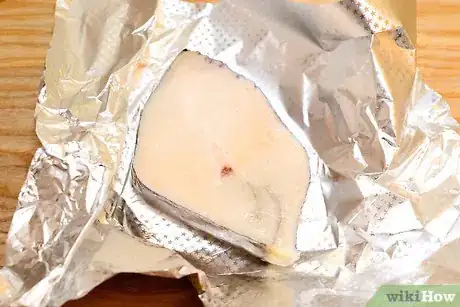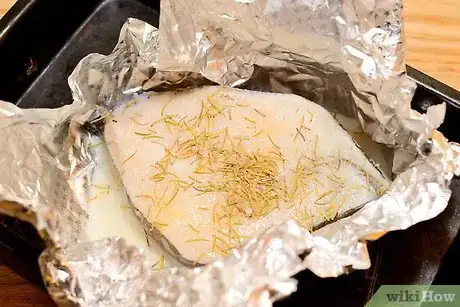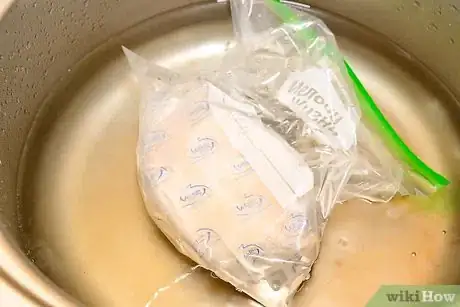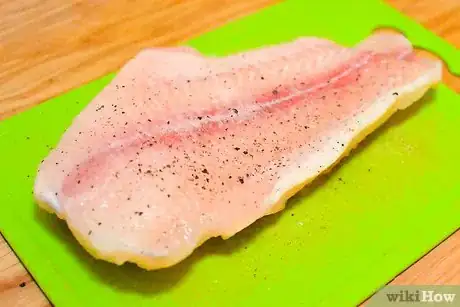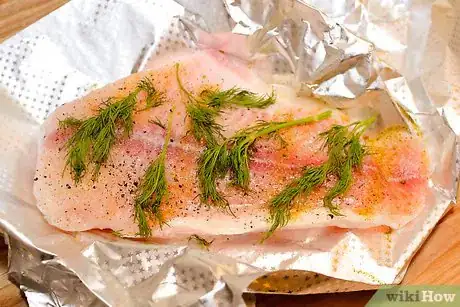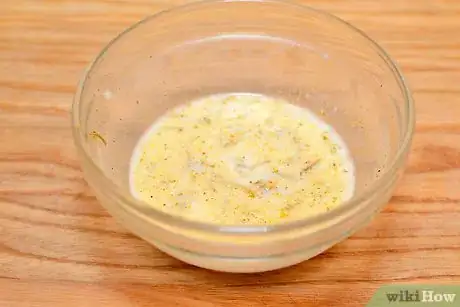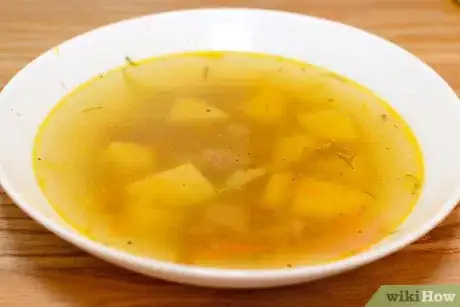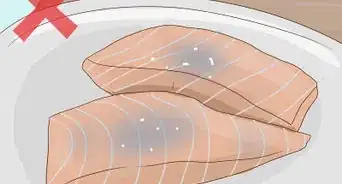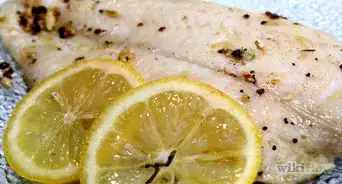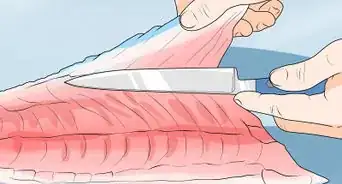This article was co-authored by wikiHow Staff. Our trained team of editors and researchers validate articles for accuracy and comprehensiveness. wikiHow's Content Management Team carefully monitors the work from our editorial staff to ensure that each article is backed by trusted research and meets our high quality standards.
This article has been viewed 320,758 times.
Learn more...
When frozen correctly, fish will retain a high quality flavor and texture, and is considered equal to fresh fish by many chefs.[1] You can even cook frozen fish without thawing, although special techniques are recommended for grilling or pan-searing. Try it out, and if you don't like it, there are plenty of ways to defrost frozen fish without affecting safety or quality.
Steps
Cooking Frozen Fish without Thawing
-
1Rinse the fish in cold water. Rinse the frozen fish in cold water to remove ice crystals from the surface. Avoid warm water, since this can promote bacterial growth and waterlog your fish.[2]
- Always wash your hands in warm, soapy water before handling raw fish.
- If the fish has not been gutted, use the thawing method below instead, then remove the inedible portions.
-
2Dry the fish. Pat the fish dry with a paper towel. This will remove additional ice crystals, as well as the moisture clinging to the fish scales.Advertisement
-
3Use special techniques for thick fish or high-heat cooking. Thick slabs of frozen fish will take a long time to cook, but you can reduce this by wrapping them in foil or parchment pouches. The ice crystals in the fish will turn to steam, remain trapped in the packet, and help cook the fish more quickly. Increasing the cooking speed is especially important for high-heat cooking methods, as described below:
- Grill fish in tightly closed foil packets, to prevent the outside charring while the inside cooks.
- If pan-searing the fish, do not wrap the fish. Instead, cover the pan once the fish begins releasing juices, to trap steam that helps cook the fish evenly.
-
4Season the fish partway through cooking. Cooking the fish for a couple minutes will melt some of the ice on the exterior. This makes it easier to rub oil, butter, or marinade into the fish, and to get spices to stick.[3] If you are breading the fish, you can place them fully frozen in a pan and cover with a thick layer of bread crumbs and spices.
-
5Cook for twice as long as you would fresh fish. You can cook frozen fish however you would normally cook fish, or look in the recipes section for ideas. Frozen fish can take twice as long to cook as fresh fish, but you're still saving time by skipping the thawing stage. This is only a general time estimate, and the actual amount of time required varies base on the thickness of the fish. Check on the fish every couple minutes, using the following tips to tell when its done:
- Cut a slit with a sharp knife. When done, the fish will be completely opaque near the surface, and just starting to become opaque in the center.
- If you have a food thermometer, cook the fish to an internal temperature of 145ºF (62.8ºC).[4]
Methods of Thawing Fish
-
1Thaw for eight hours in the refrigerator. The colder the thawing temperature, the less likely that harmful bacteria populations will grow on your fish. Thawing overnight is the recommended method whenever you have the time.[5] Keep your fridge below 46ºF (8ºC) to keep your fish safe, and cook with 48 hours.
- Frozen foods will produce water as the ice melts, so keep your fish in a container that can catch water. To avoid waterlogging your fish, you could punch holes in the base of that container, and place it above a second container that will catch the draining water.
- While most fish will thaw within 8 hours, massive amounts of fish could take up to 24 hours.
-
2Thaw under cold water. If you don't want to wait for hours to thaw your fish, seal it inside a zip locked bag and submerge it in cold water.[6] This method usually takes 1–2 hours per pound (0.45 kg) of fish, and is the fastest method that still retains quality.
- Never use water at room temperature or warmer, as this encourages the growth of bacteria..
-
3Defrost in a microwave. This method is not recommended for most circumstances, since the uneven cooking will usually make part of the fish rubbery before the rest of it is defrosted. It is typically much faster than the other methods, however, taking about 3–6 minutes per pound (0.45 kg) with most microwaves. Check on the fish halfway through, and flip each piece over.
-
4Cook as usual. Once the fish is pliable, meaning it is no longer stiff, it is fully thawed. Cook it as you would a fresh fish, or take a look at the recipes section for ideas.
- Note that the fish will still be cold once thawed.
Fish Recipes
-
1
-
2Get ideas for your specific type of fish. Different types of fish have different flavors and textures, so recipes often specify an exact type. Learn about cooking halibut, snapper, grouper, flounder, tilapia, or salmon.
- Remember that cooking frozen fish without thawing will typically take twice as long as the recipe calls for.
-
3Try new marinades and seasoning. Unlike red meat, most fish picks up on flavoring after only 5–15 minutes of marination. This makes it easy to season and flavor even if cooking it from frozen. Make sweet and sour fillets, fish in cheese sauce, Cajun style blackened fish, or Mexican style fish for tacos.
-
4Learn unique recipes. Some recipes call for less typical methods of preparing fish. These don't have to be difficult with the right instructions, and usually just involve cooking the fish along with other ingredients. Try cooking chowder, fish quiche, battered fish & chips, or kedgeree.
Community Q&A
-
QuestionHow do I cook frozen fish in the microwave?
 Community AnswerDon't cook frozen fish in the microwave; it will not cook the fish properly. Instead, use the microwave for defrosting the fish prior to cooking it in the oven, on the stove, on the grill, etc.
Community AnswerDon't cook frozen fish in the microwave; it will not cook the fish properly. Instead, use the microwave for defrosting the fish prior to cooking it in the oven, on the stove, on the grill, etc. -
QuestionCan I cook frozen fish in the oven?
 Community AnswerYes. An online search should bring up many recipes and ideas you could use.
Community AnswerYes. An online search should bring up many recipes and ideas you could use. -
QuestionWhat temperature should the fish be cooked at?
 Community AnswerLet it thaw out first in warm water for about five minutes, then put it in the oven at 375 degrees.
Community AnswerLet it thaw out first in warm water for about five minutes, then put it in the oven at 375 degrees.
Warnings
- Overcooking is a common with fish recipes, and can result in dry, unappealing flesh. If the flesh is opaque all the way through, remove it from heat immediately.⧼thumbs_response⧽
- Store leftover cooked fish in clean, closed containers in the freezer or refrigerator within 2 hours of cooking (1 hour in hot weather).[7]⧼thumbs_response⧽
References
- ↑ http://www.washingtonpost.com/wp-dyn/content/article/2008/07/29/AR2008072900707.html
- ↑ http://ext100.wsu.edu/ferry/wp-content/uploads/sites/12/2014/02/Safe-Handling-of-Fish-Poster.pdf
- ↑ http://www.cookinglight.com/cooking-101/techniques/how-to-cook-frozen-salmon
- ↑ http://www.fsis.usda.gov/wps/wcm/connect/625d9435-4f14-46fe-b207-5d6688cb4db5/Safe_Miminum_Internal_Temperature_Chart.pdf?MOD=AJPERES
- ↑ http://ext100.wsu.edu/ferry/wp-content/uploads/sites/12/2014/02/Safe-Handling-of-Fish-Poster.pdf
- ↑ http://ext100.wsu.edu/ferry/wp-content/uploads/sites/12/2014/02/Safe-Handling-of-Fish-Poster.pdf
- ↑ http://ext100.wsu.edu/ferry/wp-content/uploads/sites/12/2014/02/Safe-Handling-of-Fish-Poster.pdf
About This Article
If you want to cook frozen fish without thawing it first, rinse the fish in cold water to remove any ice crystals from the surface and pat the fish dry with paper towels. If you’re grilling, broiling, or baking the fish, wrap it in a pouch made from foil or parchment paper. If you prefer to pan-sear the fish, cover the pan. Either method will allow the steam from the ice to help cook the fish faster. Cook the fish for twice as long as you would for thawed fish. Keep reading to learn how to thaw out frozen fish before you cook it!


